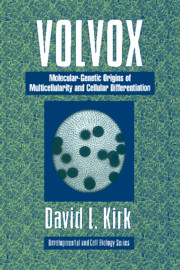 Volvox
Volvox Book contents
- Frontmatter
- Contents
- Preface
- Prologue
- 1 Introduction
- 2 The Volvocales: Many Multicellular Innovations
- 3 Ecological Factors Fostering the Evolution of Volvox
- 4 Cytological Features Fostering the Evolution of Volvox
- 5 Volvox carteri: A Rosetta Stone for Deciphering the Origins of Cytodifferentiation
- 6 Mutational Analysis of the V. carteri Developmental Program
- 7 Molecular Analysis of V. carteri Genes and Development
- Epilogue
- References
- Index
7 - Molecular Analysis of V. carteri Genes and Development
Published online by Cambridge University Press: 16 December 2009
- Frontmatter
- Contents
- Preface
- Prologue
- 1 Introduction
- 2 The Volvocales: Many Multicellular Innovations
- 3 Ecological Factors Fostering the Evolution of Volvox
- 4 Cytological Features Fostering the Evolution of Volvox
- 5 Volvox carteri: A Rosetta Stone for Deciphering the Origins of Cytodifferentiation
- 6 Mutational Analysis of the V. carteri Developmental Program
- 7 Molecular Analysis of V. carteri Genes and Development
- Epilogue
- References
- Index
Summary
I believe that … the offspring owes its origin to a peculiar substance of extremely complicated structure, viz., the “germ–plasm”. This substance can never be formed anew; it can only grow, multiply and be transmitted from one generation to another.
… we may now hope to succeed in recognizing the probable explanations among the many possible ones. … This will assuredly be the work of time, and our approach to the truth will be a very gradual one. … What … appears to afford additional promise of success is that we can … approach from two sides; – namely, by observations, firstly on the phenomena of heredity, and secondly, on the hereditary substance itself, with which we are now of course acquainted.
Weismann (1892b)… understanding cell differentiation in Volvox will require knowledge of its nucleic acid metabolism. …
Kochert and Sansing (1971)When he was writing his magnum opus, it is unlikely that August Weismann had any notion just how gradual the “approach to the truth” regarding the role of the hereditary substance in embryonic development would be in the next eight decades – or how different the outcome would be from the one that he was predicting! On the other hand, it is equally unlikely that when Kochert published the first studies of Volvox nucleic acids (only three years after he had described development in the forma of Volvox carteri that carries Weismann's name) he could have anticipated how dramatically the pace – and indeed the very nature – of studies of “nucleic acid metabolism” was destined to change in the next two decades.
- Type
- Chapter
- Information
- VolvoxA Search for the Molecular and Genetic Origins of Multicellularity and Cellular Differentiation, pp. 258 - 323Publisher: Cambridge University PressPrint publication year: 1997


